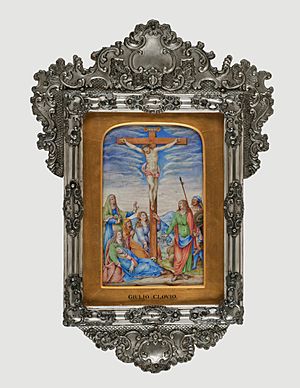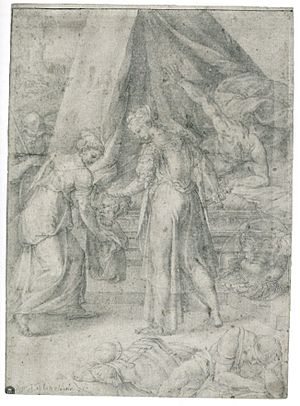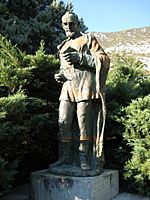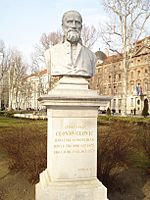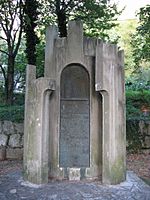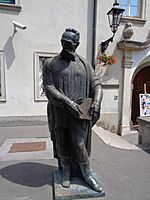Giulio Clovio facts for kids
Quick facts for kids
Giulio Clovio
Juraj Julije Klović |
|
|---|---|
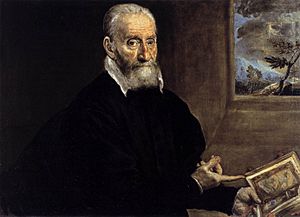
Portrait of Giorgio Giulio Clovio, pointing to his Farnese Hours, by El Greco.
|
|
| Born | 1498 Grižane, Kingdom of Croatia
|
| Died | 5 January 1578 (aged 79–80) |
| Known for | Illuminator, miniaturist, and painter |
|
Notable work
|
Farnese Hours |
| Movement | High Renaissance |
Giulio Clovio (born Juraj Julije Klović) was a famous artist from Croatia. He was born in 1498 and died in 1578. He was known for painting tiny, detailed pictures in books. This art is called "illuminating" or "miniature painting." He worked mostly in Italy during the exciting time of the Italian Renaissance. Many people think he was the best miniature painter of his time. He was one of the last great artists to create illuminated manuscripts.
Contents
About Giulio Clovio's Life
Giulio Clovio was born in a village called Grižane in the Kingdom of Croatia. Today, this area is part of Croatia. He came from a Croatian family. People often called him Clovio Croata, which means "Clovio the Croatian."
We don't know much about his early art training. He might have learned from monks in a place called Rijeka when he was young.
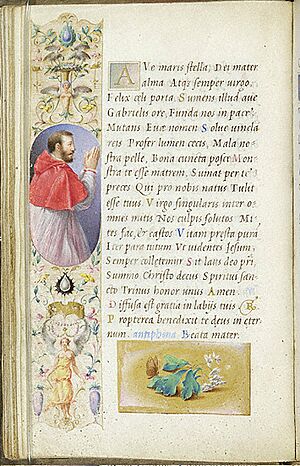
When he was 18, Clovio moved to Italy. He joined the household of Cardinal Marino Grimani. There, he was trained to be a painter. From about 1516 to 1523, Clovio might have lived in Rome. During this time, he studied art with famous painters like Giulio Romano and Girolamo dai Libri.
Clovio also made medals and seals for Cardinal Domenico Grimani. He even worked on an important early illuminated book for him.
Around 1524, Clovio went to Buda in Hungary. He worked for King Louis II. He painted two pictures for the king: "Judgment of Paris" and "Lucretia." After the king died in a battle, Clovio returned to Rome.
Later, Clovio became part of the household of Cardinal Alessandro Farnese. He stayed with Farnese until he died. During this time, Clovio created one of his most famous works, the Farnese Hours. He also made illustrations for the Towneley Lectionary.
From 1551 to 1553, Clovio worked in Florence. He painted a small picture of Eleanor of Toledo during this period.
Friends with Other Artists
Clovio was good friends with El Greco. El Greco was a famous Greek artist from Crete. He later worked in Spain. El Greco painted two portraits of Clovio. In one painting, Clovio is shown next to other great artists like Michelangelo, Titian, and Raphael. Clovio was even called the Michelangelo of the miniature because his small paintings were so amazing.
Clovio was very good at bringing the style of large Renaissance paintings into tiny miniature art. His skill made his illustrated books very famous.
Pieter Bruegel the Elder was another friend of Giulio Clovio. Bruegel stayed with Clovio in Rome in 1553. Bruegel even added a small picture of ships in a storm to one of Clovio's miniatures.
Major Artworks
The Farnese Hours
Clovio's most famous work is the Farnese Hours. He finished it in 1546 for Cardinal Alessandro Farnese. It took him nine years to complete! This book has 28 miniature paintings. Most of them show scenes from the Old and New Testaments of the Bible. There is also a famous two-page picture of a procession in Rome. The book has beautiful silver-gilt covers.
The Towneley Lectionary
The Towneley Lectionary is now in the New York Public Library. It probably belonged to Cardinal Alessandro Farnese. This book was used during church services. It has six large, full-page miniature paintings. These pictures introduce readings from the Bible. They include scenes like the Nativity (birth of Jesus), the Resurrection, and the Last Judgment.
The Colonna Missal
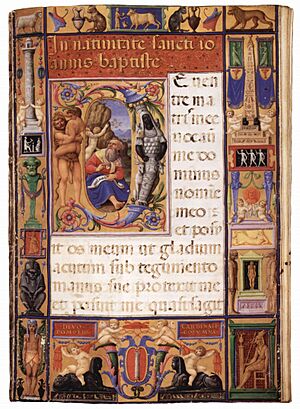
This artwork is now in the John Rylands Library in Manchester. The Colonna Missal was made for Cardinal Pompeo Colonna. For a while, people weren't sure who painted it. Some thought it might be by Raphael. But now, most experts agree that Giulio Clovio created it.
Other Important Works
The British Library has twelve full-page miniatures by Clovio. These show the victories of Emperor Charles V. The Vatican library has a manuscript about Frederigo III di Montefeltro, Duke of Urbino, which Clovio beautifully illustrated.
Other works by Clovio are kept in libraries in cities like Vienna, New York City, Munich, and Paris. Many are also in private collections. A big exhibition of his art was held in 2012 in Zagreb, Croatia. The art gallery there, Klovićevi Dvori, is named after him.
Clovio also designed many costumes for a fancy wedding celebration in 1565. This shows that Renaissance court painters often had many different duties.
Death and Burial
Giulio Clovio died in Rome on January 5, 1578. He is buried in the Basilica of San Pietro in Vincoli church. This church is also where Michelangelo's famous Moses sculpture is located.
Celebrating His Legacy
In 1998, Croatia celebrated the 500th anniversary of Giulio Clovio's birth. The Croatian National Bank made a special silver coin to remember him. A monument to Clovio was also built in Drivenik. The Croatian government recently bought Clovio's painting, The Last Judgement. Clovio had given this painting as a gift to Pope Clement VII.
A film about him, called The Gospel According to Klović, was released in 2006. The Vatican also celebrated his anniversary with special postal stamps.
Today, Giulio Clovio is honored in both Italy and Croatia. He was born in Croatia and always said he was Croatian. But he spent most of his life working in Italy. Because of this, he is often called an Italian painter.
Sculptures
-
Bust in Zrinjevac park, Zagreb
See also
 In Spanish: Giulio Clovio para niños
In Spanish: Giulio Clovio para niños
- Croats of Italy



